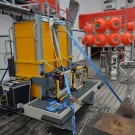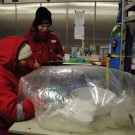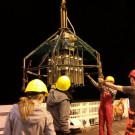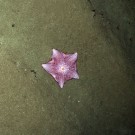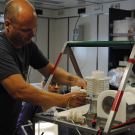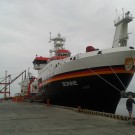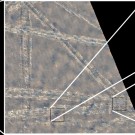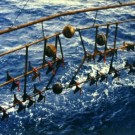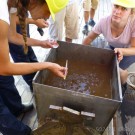Our ROV (remotely operated vehicle) substitutes our eyes and arms at depth, but the amount of instrumentation it is able to carry (the so-called payload) is limited to the available space and weight of the payload in water since the ROV is kept buoyant by its own floatation (the yellow syntactic foam on the upper […]
Polar suits in the Pacific – sediment sampling for geochemical analyses
¡Hola! We are Seinab and Sophie from Jacobs University Bremen. It is the first big research cruise for both of us and we are excited to be part of it. Instead of looking at sea cucumbers and worms, we work with mud. Here we would like to give an introduction to the geochemical sampling we […]
How to study small organisms dwelling the seabed
Among all the amazing high-tech equipments that are being used in this SO242/2 Sonne cruise, such as the OFOS (Ocean Floor Observation System), the ROV (Remotely Operated Vehicle) and Landers measuring different environmental conditions at the seafloor, I present you a very traditional equipment used ubiquitously in deep-sea research: the Multicorer, or the MUC, as […]
Tracking the impact on Deep Sea Life
The SO242-1 cruise used an Autonomous Underwater Vehicle (AUV) to visually and acoustically inspect and map the ploughmark traces on the seafloor made by the DISCOL experiment in 1989. During SO242-2 we are using their survey data to plan a series of close up studies of the seafloor using the new Ocean Floor Observation System […]
What are you working on?
Before my shift in the lab begins I went for a walk around the ship. In the first laboratory I find Tanja and Dick (NIOZ) testing whether the algae injector of their deep-sea incubator works properly and does not release the algae before the instrument reaches the seafloor. For the test they use tea because […]
SO242-2 Back to DISCOL
With the second expedition the scientific crew on board changed, because the scientific focus is different to the first leg. This brought me on board of the “SONNE”. Here I will work as a lab assistant and I will try my best to report about the expedition in my free time. Right in the middle […]
Pictures from the sea floor
by Kevin Köser Today is already Friday, the 21st of August and the cruise is about to reach its end. Although the last 4 weeks have been quite a while, when you are busy, time flies by quickly and on Sunday we already have to steam back to Guayaquil. The ship and the gear is […]
How it all began
By Gerd Schriever Many different mineral resources can be found on the deep sea floor. Beside manganese nodules, manganese crusts, massive sulphides and rare earth elements are of commercial interest. The first manganese nodules were found in 1872 during the English “Challenger” expedition in the Atlantic Ocean but were quickly forgotten. During the late 1960s/early […]
My piece of cake
By Dr. Clara Rodrigues and Dr. Patricia Esquete Garrote, Universidade de Aveiro, Portugal The Box-corer is one of the stars of this DISCOL revisited cruise. This stainless steel sampling box has been used since the 1980s to determine the fauna composition at the abyssal floor. The surface area of the box is a quarter of […]
The veteran’s tales
By Gerd Schriever Today it is my turn to write something about our cruise SO 242 leg 1 – DISCOL – Revisited. My name is Gerd Schriever and I am the “veteran” mentioned in an earlier blog entry. “Veteran” means that I am probably not just the oldest person but also the only one on […]
